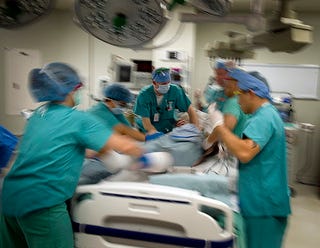Preparing for the Acute Care Environment of the (Near) Future with Wireless
January 3, 2013
Every hospital emergency department "should brace itself for a never-ending rush hour," recently advised noted ER doc Wesley Curry, MD. Curry, who is the CEO of the acute care management firm CEP America, estimates that emergency department visits in the United States could exceed 200 million visits annually by 2020. He draws his conclusions from detailed analysis of more than 80 emergency departments as well as several megatrends affecting the domestic healthcare infrastructure.
|
Wireless technology can help facilitate collaboration in acute care environments. U.S. Navy photo from Flickr. |
Developers of medical devices that are used in the acute care ecosystem should consider how wireless technology could address these growing pains. In the not-too distant future, acute care environments will likely be completely wireless, says Stacey Chang, associate partner and director of IDEO's Health & Wellness practice. And in order to be relevant, medical devices will have to interface with that infrastructure.
There are a whole host of ways wireless technology can help acute care environments, Chang says. Consider, for instance, how equipping an EMT with wireless technology can enable vital patient information to be sent to a receiving hospital before the patient arrives there, he adds. The hospital can begin preparing for the patient in advance by, for example, prepping the operating room or analyzing the patient's vital signs. Wireless technology has a lot of potential to improve the coordination of care in an emergency situation, he adds.
|
Stacey Chang |
Wireless technology can also help on the other end of the spectrum where inpatients admitted to a hospital have been discharged from the ER and the ICU. In this scenario, teamwork between the various clinicians and hospital employees is vital. "There might be a doctor, a nurse, a social worker, and a caseworker," Chang says. "They are all assigned to these patients and they have to collaborate in an efficient way," he adds. "Here's a classic example of where wireless can help: after physicians do their rounds and issue orders, those orders have to be prioritized by a nurse. The nurse usually does that by paper and pencil in a notebook and that is prone to a lot of mistakes and mis-prioritization," Chang says. A mobile wireless system has a lot of potential to help nurses prioritize what matters.
Chang will share more thoughts on how wireless technology can improve acute care in an upcoming talk at MD&M West in Anaheim on February 13. "IDEO's gist on all of this is the technology is great, but if you are not actually solving the end needs of the different stake holders, then it is not actually all that useful," he explains. "I wanted to [illustrate] the different ways that technology gets delivered so people can think a little bit more about what they are actually trying to achieve as opposed to just making something wireless to eliminate wires and clutter."
Brian Buntz is the editor-at-large at UBM Canon's medical group. Follow him on Twitter at @brian_buntz.
About the Author(s)
You May Also Like


.png?width=300&auto=webp&quality=80&disable=upscale)

